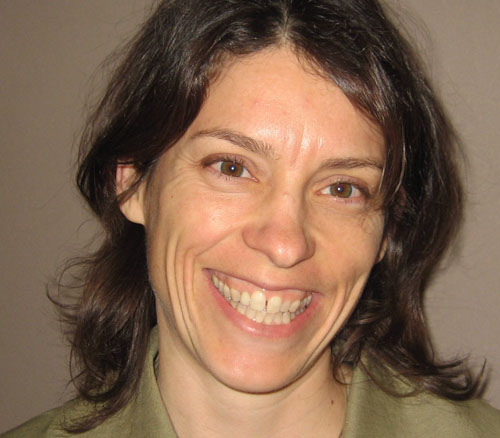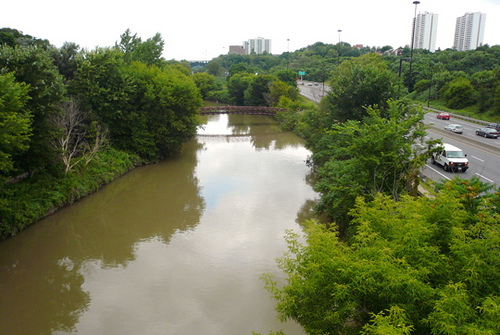
Jennifer Bonnell became interested in the Don River because it was so different from the rivers she’d known as a child. “When I first moved to Toronto in 2001, I rode my bike a lot to familiarize myself with my new surroundings. The bike path along the Don was one of the places I returned to again and again.
“Having grown up on Vancouver Island, the rivers I knew were rushing, powerful and relatively clean. I had little experience with urban rivers. I was struck by the fact that despite the Don’s insignificant size, and its polluted condition, people were still drawn to it – to walk or cycle along it, to sit below bridges along its lower reaches. The lower river is an ugly and neglected place, and I wondered what drew people here.”
Those thoughts came to Bonnell, now a post-doc at the University of Guelph, at a time when she was looking for a new research project for her PhD. She decided to study the history of the Don River and how it became what it is today.
She’ll be presenting that story on Nov. 29, from 2:30 to 4:30 p.m. as part of the annual Rural History Roundtable hosted by the Department of History. Her presentation is titled “An Environmental History of an Urban Borderland: Toronto’s Don River Valley 1860-1930,” and will be held in Johnston Hall, Room 104.
What made the Don River Valley an urban borderland? Bonnell explains that historically, the Don was the eastern border of Toronto, forming a boundary between the city and the country. “Lieutenant-Governor John Graves Simcoe originally located the town of York (now Toronto) near the base of this river, but as the town grew it moved to the west and north,” she says.
In the 1790s and early 1800s, the river was important to the growing community as a source of timber, clay, and water power for milling operations. However, by the late nineteenth century, says Bonnell, noxious industries congregated along the lower river, including tanneries, oil refineries, and slaughterhouses.
“The river became a dumping ground for sewage and industrial waste, a polluted periphery that was ‘out of sight, out of mind’ for most people. “Remember, this is a tiny urban river, not the Thames or the St. Lawrence,” says Bonnell. “It became heavily polluted and actually caught fire several times in the early twentieth century.”
It was not only pollution that made people avoid the Don, but also ideas about the healthiness of certain kinds of landscapes. At the time, people believed that “miasmas” – or vapours produced by rotting organic material – were a source of disease. The massive Ashbridge’s Bay Marsh at the mouth of the river, with its stagnant waters and rotting vegetation, was considered a place that could make you sick. In a way, people were right: the marsh’s thriving mosquito population meant those who lived near the marsh were exposed to malaria. Those who could moved away from the area.
The river remained the city’s boundary until 1884 when Riverdale was annexed. Topography also contributed to the valley’s borderland status. There were no bridges over the Don north of Gerrard until 1918, so the deep valley significantly slowed the growth of the city to the east.
Not only was the river a place for disposing of waste, it also became a place to contain people – people the rest of the city “didn’t want to see.” Bonnell says that in the 1800s the lower valley housed isolation hospitals, the Don Jail and a home for the elderly poor. “It also increasingly became a place of refuge for the homeless and a hideaway for gangsters and petty criminals.”
Bonnell’s journey to the Don River began with her research for her master’s thesis, at the University of Victoria. “I was interested in the First Nations’ oral histories and how B.C. First Nations were mapping their traditional land uses to support their land claims.” After travelling for a few years and working on various projects, she moved to Toronto and worked with the Multicultural History Society of Ontario. “I was able to focus again on oral history and co-ordinated an oral history project on the history of Agincourt, a very multi-cultural community in Scarborough,” she says.
In 2004, she returned to graduate school to train as a historian. Her earlier studies had been in environmental studies and not history, but she found a home for her work at the Ontario Institute for Studies in Education at the University of Toronto. “My ongoing interest,” Bonnell says, “is in people’s connection with the past through particular places, in environmental history and public memory.”

The history of the Don River is a natural fit for someone interested in environmental issues; in 1969 the environmental group Pollution Probe held a funeral for the river, which had become so polluted that it supported only the hardiest of fish species.
“Citizen activism transformed perceptions of the river,” says Bonnell. “People imagined what the river and surrounding space might become. Small, incremental projects by groups such as the Task Force to Bring Back the Don have restored wetlands and replanted trees along valley slopes.” However, the Don lies within the most urbanized watershed in Canada, so opportunities for restoration are limited.
Bonnell hopes her research will encourage more people to look at Toronto’s Don River with new eyes. Throughout its history, the river has served as a symbol of the city’s relationship with the environment on which it depends. “The river is what it is because of particular decisions that have been made in the past. We can choose to make it something different, something better, in the future.”